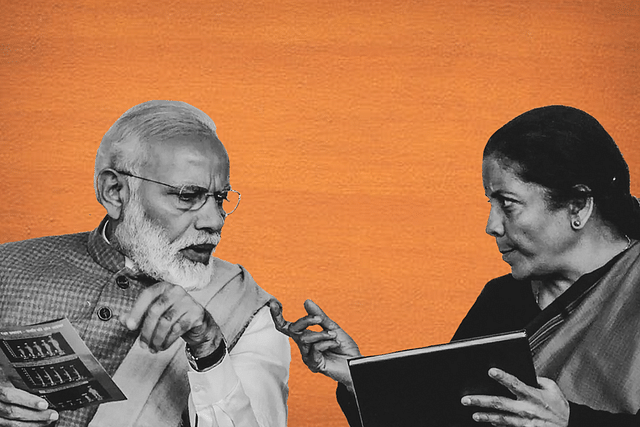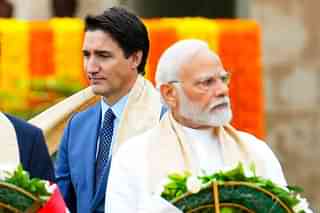Economy
Why The 'P' Word Has Disappeared From The Modi Government's Discourse
R Jagannathan
Feb 20, 2024, 02:00 PM | Updated 02:00 PM IST
Save & read from anywhere!
Bookmark stories for easy access on any device or the Swarajya app.

Ever since the Narendra Modi government “sold” Air India to the Tatas in 2021-22, the ‘P’ word has practically disappeared from the public discourse.
There has been sporadic talk of selling off an IDBI Bank or the Shipping Corporation of India, but there has been little progress. Few people in government talk of privatisation per se, and instead the focus is on “asset monetisation”.
This is in sharp contrast with what Modi himself told Swarajya in an exclusive interview in 2018. In response to a query on the half-hearted efforts being made to privatise public sector companies, especially after the first bid to privatise Air India failed, he replied:
“I request you to check your facts. Our government has undertaken significant disinvestment. You can research more on this and you will come to this conclusion too. As for Air India, the government has done what it had to with utmost sincerity. You have to differentiate between the lack of response to one sale offer & a policy decision. At the cabinet level, we have cleared the sale of not only Air India but several other (loss-making) public sector units — this itself is historical in many ways; that they are yet to be sold is the result of timing and process. We don’t want to make a sale where we will be accused of selling something for X amount when we could have got more. But the policy decisions for strategic sales have already been taken.” (Italics mine)
So what has changed since 2018?
Five things primarily.
First, after a lot of effort, most public sector units are generating cash and healthy profits. Their market valuations are also hitting new highs, especially in the finance and defence sectors. So, the pressure to privatise has eased.
In the last one year, eight public sector units have crossed the market capitalisation mark of Rs 1 lakh crore, and we are not talking of the Life Insurance Corporation or the State Bank of India. The latter two are in a league of their own, with market values of over Rs 6 lakh crore each.
LIC, for the first time since it was listed, is now delivering real positive returns to the people who invested in its initial public offering in 2022. Over the last one year, the S&P BSE PSU index has risen more than 80 per cent, far ahead of the general market.
Second, there is the post-Covid policy of 'atmanirbharta', which is about expanding manufacturing in India, especially in sectors where there is over-dependence on China, and in defence, where geopolitical factors call for greater self-reliance.
Privatisation does not quite fit into this narrative as opposed to when global competitiveness was the war-cry and the assumption was that the world was moving towards more and more free trade.
Third, the government now believes that extracting high dividends from profitable public sector companies is better than selling them to the private sector, only to be later accused of selling the crown jewels for a song.
The 2024-25 interim budget expects to receive more than Rs 1.02 lakh crore in dividends from just the Reserve Bank and public sector banks. The other PSUs could also deliver more.
Fourth, Modi personally believes that making public sector companies more efficient by reducing political interference and letting them find their own path to growth is more important than selling them off.
In a 2013 interaction with CNBC TV-18’s team of journalists, when he was just candidate Modi and not PM, he did not give a clear commitment to privatisation. He said he had been successful in making Gujarat’s own public sector companies profitable, indirectly indicating that there are better alternatives to privatisation.
Fifth, and this has to do with policy. Modi knows that when you have to extend social security nets on scale and deliver to the last mile, you need the public sector. It is difficult to believe that we could have had saturation coverage of the Jan Dhan, Ayushman Bharat and Ujjwala schemes if the government had to depend on private players.
Also, given the policy of using excise increases and decreases to manage the retail prices of petroleum products, once again this can be done only if public sector oil companies are there to carry out orders.
That these companies have done so without the government bankrupting them, as the UPA did, is Modi’s real achievement. He clearly does not believe in total deregulation; he seems to prefer managed forms of deregulation.
The public sector, for now, is living up to Modi’s hopes. It should continue to do so as long as we do not have a coalition government messing things up. Most public sector managers will be hoping that Modi stays in the saddle after May 2024.
With the public sector back in the business of creating wealth, Modi has the option of going back to his basic belief of 2013 that the public sector can perform well even if it is under government control.
Save & read from anywhere!
Bookmark stories for easy access on any device or the Swarajya app.
Jagannathan is Editorial Director, Swarajya. He tweets at @TheJaggi.
Introducing ElectionsHQ + 50 Ground Reports Project
The 2024 elections might seem easy to guess, but there are some important questions that shouldn't be missed.
Do freebies still sway voters? Do people prioritise infrastructure when voting? How will Punjab vote?
The answers to these questions provide great insights into where we, as a country, are headed in the years to come.
Swarajya is starting a project with an aim to do 50 solid ground stories and a smart commentary service on WhatsApp, a one-of-a-kind. We'd love your support during this election season.
Click below to contribute.





